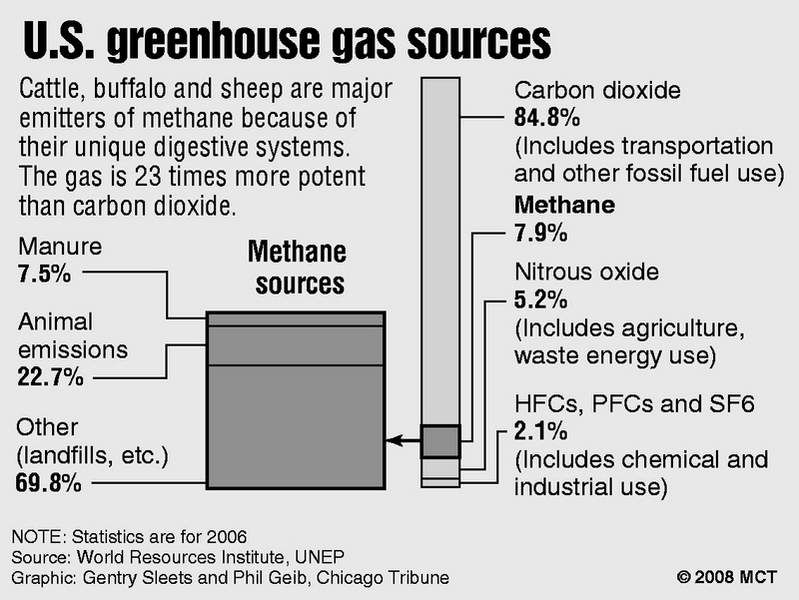Climate change scientists refocus on cow flatulence
Published 5:00 am Wednesday, August 6, 2008

- Efrain Hernandez shovels manure out of stalls at Hunter Haven Farm in Pearl City, Ill. The manure will be pushed to a drain system that will be used in the processing of methane to generate electricity.
CHICAGO — Burgeoning efforts to curb climate change pollution are taking aim at an unlikely new target: the placid, cud-chewing cow.
Scientists have long known that cattle and other livestock are a major contributor to climate change worldwide, and although researchers, regulators and activists have devoted most of their attention to other culprits — such as cars and coal-fired power plants — that is starting to change.
Trending
As dairy and beef cows chew and rechew their feed, their belches and other, er, gastric eruptions produce enormous quantities of methane, a greenhouse gas 23 times more potent than carbon dioxide.
All that cow flatulence is bad enough, but clearing forests for pastures and the manufacturing of fertilizers to grow cattle feed produce even more greenhouse gases. When those sources are considered, the United Nations estimates that the world’s livestock system is a bigger part of the problem than transportation.
Change is in the air
The impact is great enough that researchers are stepping up efforts to limit bovine burps by tinkering with cattle feed. Some large dairies, including three in Illinois, are pumping the millions of gallons of manure they produce into bacteria-filled tanks that capture methane and use it to generate electricity.
Changes are quietly taking place at supermarkets and dinner tables, too. Bon Appetit Management Co., which operates 400 cafes at universities, museums and corporate offices in the U.S., is pushing to cut the firm’s greenhouse gas emissions by 25 percent, in part by limiting the amount of beef and cheese served.
One of the company’s three local cafeterias, at Wheaton College, went so far as to stop offering cheeseburgers in the all-you-can-eat dining hall. Customers at a small campus grill are reminded that choosing a chicken sandwich instead of a burger can reduce their carbon footprint.
Trending
More carbon-efficient management of livestock, manure and food production almost assuredly will be required if Congress moves next year to reduce the nation’s contributions to climate change.
Methane is a big concern because it is so much more potent than carbon dioxide, the chief source of man-made pollution behind rising global temperatures. So is nitrous oxide, another byproduct of manure and fertilizer production. It has a whopping 296 times the heat-trapping potential of carbon dioxide.
Domestic cattle packed into feedlots and dairies might seem like an unlikely part of the problem. But because ruminants eat enormous amounts of hay, corn and other feed, then belch it up again and again as they chew their cud, a single cow can produce up to 400 pounds of methane a year.
The manure they leave behind is a malodorous mess that churns even more methane into the air. All told, the U.S. Environmental Protection Agency estimates that livestock burps, flatulence and waste accounts for more than a quarter of the nation’s methane emissions, second only to decomposing garbage in landfills.
Methane = money
In the rolling hills of northwest Illinois, where the pungent scent of cow digestion fills the air, Doug and Tom Block have figured out a way to turn the familiar stink of dairy farming into cash.
When the brothers decided a few years ago to expand their Carroll County farm, they installed a huge device called a methane digester. Several times a day, the waste from more than 800 cows is dumped into a bacteria-filled tank that breaks down the muck and captures methane, which fuels a pair of hulking electrical generators nearby.
Cow power, as the Blocks call it, provides about a third of the dairy’s electricity. It also makes the brothers money through the Chicago Climate Exchange, a voluntary network of corporations and governments that trades credits for greenhouse gas emissions, similar to the way milk and beef futures are bought and sold.
By keeping methane out of the atmosphere, the dairy farmers get to sell carbon credits to companies that fail to meet their pledges to reduce global warming pollution. The arrangement recently netted the Blocks a $24,000 check, and has turned the former climate change skeptics into true believers.
“We’re greedy dairy farmers, but as we got into this we started to understand how what happens on the farm can help solve a big problem,” Doug Block said.
What else?
Another possible solution to the world’s methane problems is emerging from university laboratories. In recent years researchers have tried to come up with feed additives that cut down on cow belches — and emissions from the other end of the animal.
A group of Japanese scientists reported earlier this year that they had happened upon a methane-reducing formula of nitrates and cysteine, an amino acid.
In Australia, researchers are testing a biologically engineered grass that acts like a bovine antacid. There also are nascent attempts at several U.S. colleges to perfect what amounts to Beano for cows.
But it’s unclear if and when any of the additives might move from the lab to the barn.








